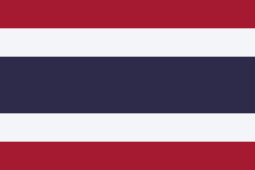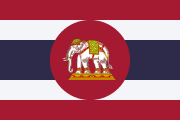Flag of Thailand
This article needs additional citations for verification. (September 2017) |
 | |
| Trairanga (Thai: ธงไตรรงค์, RTGS: thong trai rong), 'Tricolour flag' | |
| Use | National flag, civil and state ensign |
|---|---|
| Proportion | 2:3 |
| Adopted | 28 September 1917 (standardized on 30 September 2017) |
| Design | Five horizontal stripes of red, white, blue, white and red, the middle stripe twice as wide as the others |
| Designed by | King Vajiravudh (Rama VI) |
| Thai: ธงราชนาวี (RTGS: thong ratcha nawi), 'Royal Navy flag' | |
 | |
| Use | Naval ensign |
| Proportion | 2:3 |
| Adopted | 28 September 1917 (de jure) |
| Design | A red disc containing a white elephant (Airavata) in regalia centered on the national flag |
The flag of Thailand (Thai: ธงไตรรงค์; RTGS: thong trai rong, meaning 'tricolour flag') shows five horizontal stripes in the colours red, white, blue, white and red, with the central blue stripe being twice as wide as each of the other four. The design was adopted on 28 September 1917, according to the royal decree issued by Rama VI. Since 2016, that day is a national day of importance in Thailand celebrating the flag.[1]
The colours are said to stand for nation-religion-king, an unofficial motto of Thailand,[2] red for the land and people, white for religions and blue for the monarchy, the last having been the auspicious colour of Rama VI. As the king declared war on Germany that July, some note the flag now bore the same colours as those of the UK, France, Russia and the United States.[3]
Design
[edit]The Flag Act of BE 2522 (1979)[4] stipulates the design of the national flag as "rectangular in shape with 6 part width and 9 part length, divided into five stripes throughout the length of the flag; with the middle stripe being 2 part wide, of deep blue colour, and the white stripes being 1 part wide next to each side of the deep blue stripes, and the red stripes being 1 part wide next to each side of the white stripes. The National Flag shall also be called the Tri-Rong flag".[5]
Colour standards
[edit]The colours of the flag were standardised in an announcement of the Office of the Prime Minister dated 30 September 2017, on the occasion of the 100th anniversary of its adoption.[6] It gives recommended values for determining the standard colours of physical cloth flags, defined in the CIELAB colour space under Illuminant D65. RGB, HEX and CMYK values are derived by NSTDA.[7][8]
| Colour | CIELAB D65 | Other colour values | |||||||
|---|---|---|---|---|---|---|---|---|---|
| L* | a* | b* | ΔE* | RGB | HEX | CMYK | |||
| Red | 36.4 | 55.47 | 25.42 | ≤1.5 | 165-25-49 | #A51931 | C24-M100-Y83-K18 | ||
| White | 96.61 | -0.15 | -1.48 | ≤1.5 | 244-245-248 | #F4F5F8 | C3-M2-Y1-K0 | ||
| Blue | 18.63 | 7.89 | -19.45 | ≤1.5 | 45-42-74 | #2D2A4A | C87-M85-Y42-K43 | ||
Construction Sheet
[edit]History
[edit]


The first flag used for Siam was probably a plain red one, first used under Narai (1656–1688). Naval flags later used different symbols on the red ground—a white chakra, or the Hindu mythological elephant Airavata inside the chakra.
Officially the first flag was created in 1855 by Mongkut (Rama IV), showing a white elephant on red ground, as the plain coloured flag was not distinct enough for international relations.
In 1916 the flag was changed to show a white elephant in royal regalia. In 1916, the current design, but with the middle colour being the same red as the outer stripe, was defined as the civil ensign. According to a popular legend, king Vajiravudh (Rama VI) was appalled when he saw the elephant flag flown upside down by one of his subjects by accident, which caused him to order the creation of a vertically symmetrical design. Initially (1916/17), this was a purely red and white design of five horizontal stripes.[9] Later in 1917, the middle colour was changed to dark blue, which was similar in tone to indigo or purple, which at the time was regarded as the auspicious colour for Saturday, the day Vajiravudh was born. According to other sources, the blue was also chosen to show solidarity with the Allies of World War I, which also had the colours blue-red-white in their flags.
Timeline
[edit]| Flag | Date | Use | Description |
|---|---|---|---|
 |
c. 1680 – c. 1782 | A red plain rectangular flag. | |
| c. 1782–1855 | |||
 |
c. 1782 – c. 1817 | Red flag with a white chakra, presumably to represent the Chakri dynasty. | |
 |
c. 1817–1855 | Red flag with a white elephant inside the chakra. | |
 |
c. 1843–1855 | A white elephant, facing the hoist, centred on a red field. Thai: ธงช้างเผือก (Thong Chang Puak)[10] | |
| 1855–1893 | |||
| 1893–1916 | |||
 |
1893–1898 | A white elephant in regalia, facing the hoist, centred on a red field | |
| 1898–1912 | |||
| 1912–1917 | |||
 |
1916–1917 | Red flag with two horizontal white stripes one-sixth wide, one-sixth from the top and bottom | |
 |
1917–present | Flag with horizontal blue stripe one-third wide between white stripes one-sixth wide, between red stripes one-sixth wide, known as the Trairanga. |
Maritime flags
[edit]The naval ensign of the Royal Thai Navy (RTN) is the national flag with a red circle in the middle that reaches as far as the red stripes at the top and bottom. In the circle stands a white elephant, in full caparison, facing the hoist. The kingdom's naval jack is the national flag defaced with the emblem of the Royal Thai Navy in the middle. The regimental colours of the RTN is as same as this flag; both ensigns were adopted in 1917.
See also
[edit]- List of Thai flags
- Royal Standard of Thailand
- Royal Flags of Thailand
- List of Military flags of Thailand
- Flag of Costa Rica, similar design (but the red and blue colours are reversed)
- Flag of India, which has a similar name "Tiranga"
- Flag desecration in Thailand
Sources
[edit]- Macharoen, Chawingam (2002). Thong Thai Laem 1. Bangkok. ISBN 974-419-454-5.
{{cite book}}: CS1 maint: location missing publisher (link)
References
[edit]- ^ (in Thai) การฉลองครบรอบ 100 ปี การประกาศใช้ธงไตรรงค์ เป็นธงชาติไทย Archived 19 May 2017 at the Wayback Machine Thailand.prd.go.th, Retrieved September 26, 2017.
- ^ "Thailand: A Country Study". Country Studies Program, formerly the Army Area Handbook Program, from the Library of Congress. Mongabay.com. Retrieved 23 July 2011.
Sarit revived the motto "Nation-Religion-King" as a fighting political slogan for his regime, which he characterized as combining the paternalism of the ancient Thai state and the benevolent ideals of Buddhism.
- ^ Duncan Stearn (14–20 February 2003). "A Slice of Thai History: Raising the standard; Thailand's national flags". Pattaya Mail. Retrieved 24 July 2011.
The prevailing – although unofficial – view of the meaning of the five stripes is that red represents the land and the people; the white is for Theravada Buddhism, the state religion and the central purple stripe symbolises the monarchy. It has also been stated that purple was the favorite color of King Rama VI (he born in Saturday). Another account claims the purple (this refer deep blue) was inserted as a show of solidarity following Thailand's entry into the First World War (in July 1917) as an ally of Britain and France....
- ^ The Flag Act of BE 2522 (1979) (Thai: พระราชบัญยัติธง พ.ศ.2522) in Royal Thailand Gazette No. 96 Section 67, special edition page 1
- ^ "An unofficial translation from the Office of the Council of State" (PDF). Krisdika.go.th. Archived from the original (PDF) on 5 March 2017. Retrieved 9 January 2018.
- ^ มาตรฐานแถบสีธงชาติไทย [Flag of Thailand] (in Thai). National Science and Technology Development Agency. 16 October 2017. Archived from the original on 18 September 2020. Retrieved 16 February 2018.
- ^ ประกาศสำนักนายกรัฐมนตรี เรื่อง รูปธงชาติตามพระราชบัญญัติธง พ.ศ. 2522 [Announcement of the Office of the Prime Minister regarding appearance of the National Flag in accordance with the Flag Act, B.E. 2522] (PDF). Royal Thai Government Gazette (in Thai). 164 (Special 245 D): 1–2. 4 October 2017. Archived from the original (PDF) on 4 October 2017. Retrieved 4 October 2017.
- ^ สวทช. มาตรฐานแถบสีธงชาติไทย https://www.nstda.or.th/th/nstda-knowledge/11557-thaiflag-color Archived 2020-05-27 at the Wayback Machine
- ^ Znamierowski, Alfred (1999). The World Encyclopedia of Flags: The Definitive Guide to International Flags, Banners, Standards and Ensigns. Hermes House. p. 48. ISBN 9780754826293.
- ^ Roberto Breschi. "Siam Bandiera mercantile 1839" (in Italian). Archived from the original on 8 December 2004. Retrieved 25 September 2004.



